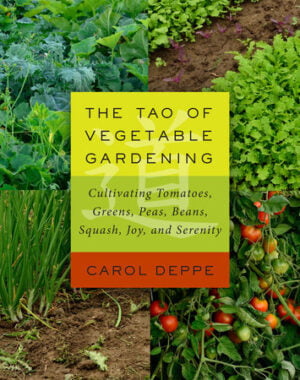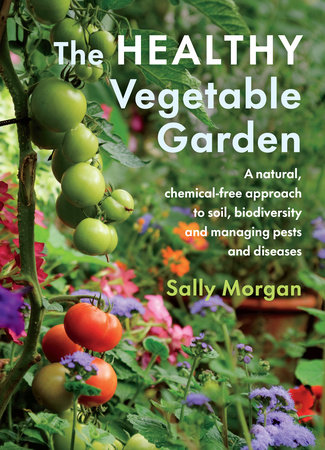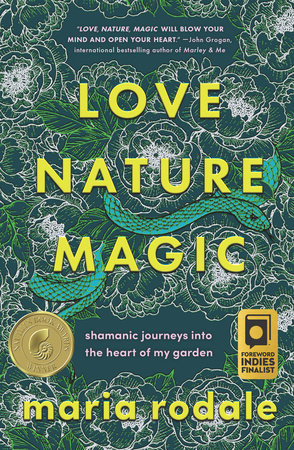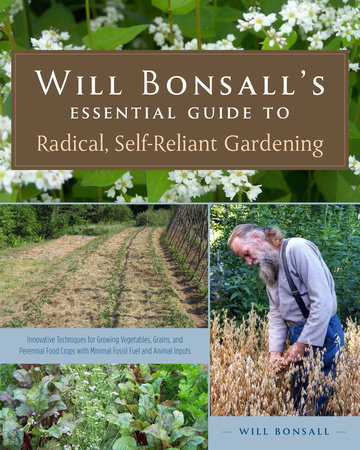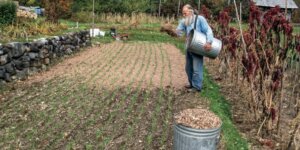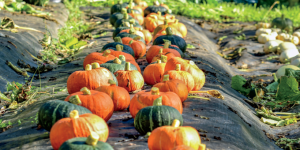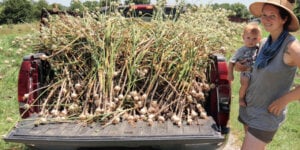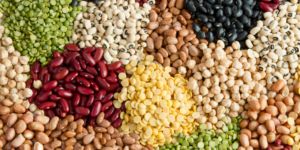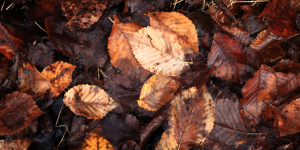A Meditation On Garden Weeding: Reflecting On A Day In the Garden
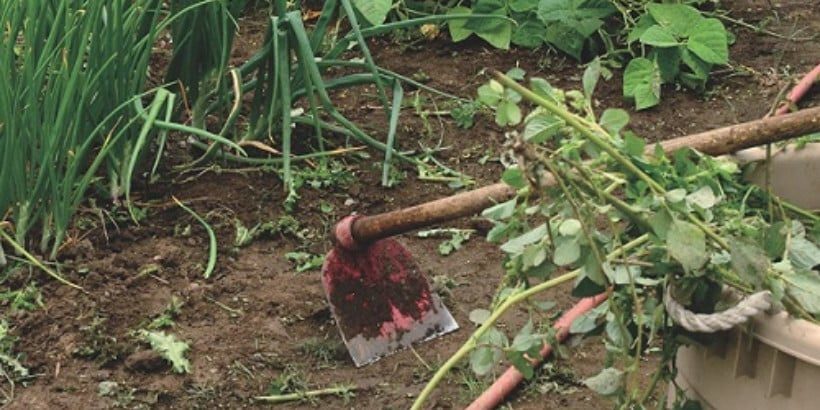
Gardening takes hard work; so it may slip your mind to take a moment, step back, and look at all you’ve accomplished. You might just come across some new ideas to improve your garden. In the excerpt below, author Carol Deppe reflects on her time spent garden weeding and how her actions can often transcend the moment (or the task) at hand.
The following is an excerpt from The Tao of Vegetable Gardening by Carol Deppe. It has been adapted for the web.
Just Another Day: Garden Weeding & Other Daily Tasks
First thing in the morning in the garden I do any planting that is needed. This takes more disciplined focus and attention to detail than most of the rest of gardening, which takes other kinds of things.
Next comes weeding. I do this after planting, but still early in the morning while it is cool and the work is pleasant. Sometimes when I weed I am thinking just about the particular plants I’m weeding and noticing things about the patch I’m working in. Often my thoughts stay focused on that area, but go broader. I am weeding the squash patch that’s full of all my breeding projects. My mind floats free and imagines all the varieties these plants might become.
Finding Inspiration While Weeding
Sometimes I get ideas for other breeding projects. Or practical ideas. Hmm. If I plant both this and that, and emasculate these on this day and those on that day, I can do two different breeding projects in this one patch with no isolation. Sometimes what comes are simple observations that I’ve made hundreds of times, but now I focus on them differently. Hmm.
These two summer squash varieties really are the most vigorous. I’ve grown them each several different years and they always come up first and establish themselves earliest. I should cross the two and see if I can get something even more vigorous. Maybe mass-select explicitly for vigor and see what happens. Sometimes there are random flashes of insight that I will write down later to use in a book.
Sometimes, though, I go into a different state of consciousness entirely while weeding. I feel the gentle breeze on every hair on my arms. The air temperature is so perfect, so soothing, it’s hard to tell exactly where my skin stops and the rest of the world starts. The sounds of birds in the adjacent wetland merge with sounds of my hoeing and the sounds of traffic from the highway—wildness, garden, and urban civilization all represented, juxtaposed—myself a part of all three worlds, at home in all of them.
I am aware of every muscle as I wield the hoe. Or as the hoe wields me. The person and the garden are one. Bees are working the flowers. A person is hoeing the squash. A caterpillar is chewing a leaf quite noisily.
Where Carol is I’m not quite sure. There is no “I” nor any “Carol” to wonder. Joy is.
Presently, Carol returns, rejuvenated.
Open-Ended Noticing: A Walk Through the Garden
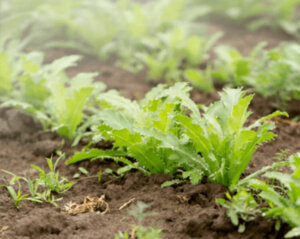 It’s midmorning in the garden. It’s getting warmer and I’ve had enough exercise for the day. I evaluated and recorded the results from a garden trial first thing in the morning. Then I weeded while it was still cool. Then I picked the vegetables for lunch and dinner. Now I wander around the garden just noticing things.
It’s midmorning in the garden. It’s getting warmer and I’ve had enough exercise for the day. I evaluated and recorded the results from a garden trial first thing in the morning. Then I weeded while it was still cool. Then I picked the vegetables for lunch and dinner. Now I wander around the garden just noticing things.
This is an open-ended noticing. I’m not looking for anything specific. I’m just looking. Looking in a maximally open frame of mind. Just enjoying being in the garden, wandering around with no goals or purpose, and letting myself see.
There are damp places in the squash patch from the last watering, though the surface of the ground in most of the patch is dry, clearly marking which parts are getting more water than the rest. Are the plants in those spots doing better? If so, it means my squash patch is water-limited and the rest would do better with more water. No. The squash outside the damp areas are doing just as well. All the squash are all getting enough water.
But what’s this? This squash plant has a leaf type quite different from the others in the variety. It’s bought seed, not a variety of my own. That unusual plant could be an accidental cross. How much variability is there in this material? Hmm. A lot. This entire variety may be crossed up. Don’t bother saving seed on this variety this year. Just grow it this year and see if it is what it is supposed to be. I’ll know more once it starts making fruits.
A New Discovery While Garden Weeding
In the lower corners of the corn patch the plants are stunted. Not getting enough water. I could do an extra set of the sprinkler, but that would cost labor and most of the water from the extra set would go outside the garden. Instead, when I weed I will thin the corn plants in those corners to much farther apart so they will be productive on the amount of water they are getting. Maybe I’ll even eliminate the corn plants in the two dry corners and let the interplanted nasturtiums have all the space.
Speaking of which, why are these nasturtium plants so small? They should be tall. That’s the only kind I ever buy. But these are a small type. I taste one. Leaves just as tasty. They are actually pretty handy for the dry corners of the corn patch. They don’t seem to mind the lower water ration. But the seed I bought was obviously not what it was supposed to be. I don’t know what variety these nasturtiums are. The leaves are small compared with those of the tall type; not as good for sandwiches or salads.
But the variety is very nice to have in the dry corners of the corn patch. The nasturtiums in those corners are doing just as well as the nasturtiums in the better-watered areas. They clearly don’t need as much water as the corn.
The pole bean seedlings emerging in the corn patch are covered with cucumber beetles and are getting eaten up. Obviously this year the cucumber beetles and the pole bean seedlings emerged at the same time. Bad news for the seedlings. However, I planted four or five times as many seeds as I needed just in case, knowing that this planting was near the beetle-problem window.
Insects and Diseases: Assessing the Damage
Looks like I’ll lose 80 percent of the plants but still end up with a good stand, the beetles having done the thinning. However, the yard-long beans (a kind of cowpea) growing in the same patch in alternate rows are untouched. Interesting. And it isn’t a matter of degree. Every common bean seedling has half a dozen or more beetles on it.
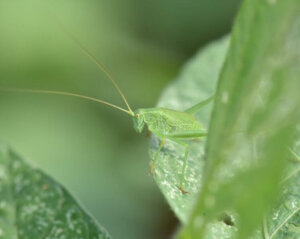 Every cowpea seedling has none. And there are a hundred or more seedlings of each. No doubt about it. The beetles don’t like the cowpea. I thought they liked about everything—every bean, cucumber, squash. Cowpeas are a Vigna, not a Phaseolus, so not even the same genus as the common beans, a fairly distant relative. And they are southern-adapted, where insects are a huge problem.
Every cowpea seedling has none. And there are a hundred or more seedlings of each. No doubt about it. The beetles don’t like the cowpea. I thought they liked about everything—every bean, cucumber, squash. Cowpeas are a Vigna, not a Phaseolus, so not even the same genus as the common beans, a fairly distant relative. And they are southern-adapted, where insects are a huge problem.
How Can Insects Affect Plants?
Do cowpeas have more defenses against insects than Phaseolus? Insects in general or just this one insect? But maybe I’m jumping the gun. Is it cowpeas in general the beetles don’t like, or just this particular variety? I have another variety of cowpea interplanted with the corn on the other side of the patch. I’ll see when I get over there.
Are any of the common bean varieties less affected by the beetles? Hmmmm. Nope. I have four varieties, dozens of seedlings of each variety, including the heirloom ‘Kentucky Wonder’ that’s good at withstanding things. The beetles seem to be going after and damaging all the varieties about the same.
Let’s see, here’s the other cowpea variety… Yipe! Some of these cowpea seedlings are mottled with yellow. Did they bring a seedborne disease into the patch? Or did they get it here? Well, there isn’t the pattern with respect to area of the field or position in the row I would expect if the disease came from the field or if one plant got it here and spread it to the others. There is a random distribution of degrees of disease in seedlings with respect to position in the field.
About 20 percent affected heavily, about 20 percent seemingly unaffected, and the rest somewhere in between. The seedlings are just 2 inches (5 cm) tall. And the other cowpea variety is having no trouble. Not a single seedling is showing any sign of yellow mottling. This yellow mottling in one variety is almost sure to be a seedborne disease this cowpea variety has brought in. A virus disease is a good bet.
Dealing With Disease
I won’t deal with it now, because this calls for serious phytosanitary measures. I’ll come back first thing tomorrow with plastic gloves and a plastic bag and pull all the seedlings of this cowpea variety and get them out of here. I’ll pull even the cowpea seedlings that aren’t showing signs of the disease. At least the ones of this variety. Most or all of them probably also have the disease; even those that don’t will have been growing right next to those that do, so might now be infected.
I’ll keep an eye on the other variety of cowpeas on the other side of the corn patch so if they have become infected, I’ll catch it soon and eliminate the entire patch. The diseased cowpea variety doesn’t have any cucumber beetles on it either. First approximation is, cucumber beetles don’t like cowpeas.
I wander back through the squash patch, then load the tools into my van and prepare to head for home. It was a good gardening day. On a good gardening day there is nothing better. On a good gardening day there is not merely nothing better. There is nothing else.
The Joy of Gardening: Simple Pleasures
The first tomatoes of the season are special. My first tomatoes are my ‘Stupice’, smaller tomatoes but full-flavored. I eat the first of them just plain out of hand. A week later and I have lots more tomatoes. I fix a big salad with just chunks of tomato, feta cheese, a touch of good-quality red balsamic vinegar, and a little pepper. The feta cheese provides the fat and the salt. I taste and get the proportions of tomato, cheese, and vinegar just perfect. That salad is dinner.
Ten days go by and the ‘Amish Paste’ tomatoes start coming on. Now I have lots of tomatoes, and bigger tomatoes. Now one major meal, lunch or dinner, of almost every day is mostly tomatoes. Cheese, scallions, and gourmet olives often find their way into salads along with the tomatoes.
I usually don’t mix greens with the tomato salad. Instead, I serve the tomatoes with cheese, scallions, herbs, and dressing on top of a bed of fresh leafy greens or cold cooked eat-all greens.
Food for Thought: Using What You Grow
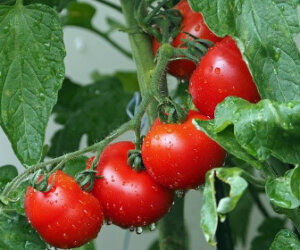 I like my tomato salads on top of the cooked cold eat-all greens best, and make sure to harvest and blanch enough eat-all greens to always have plenty of cold cooked greens in the refrigerator.
I like my tomato salads on top of the cooked cold eat-all greens best, and make sure to harvest and blanch enough eat-all greens to always have plenty of cold cooked greens in the refrigerator.
Then there are tomatoes dropped into soups and stews, just barely warmed, not cooked. I make tomato soup from tomato paste, ketchup, oregano, and red balsamic vinegar, then drop in chunks of tomatoes just before serving.
When the ‘Pruden’s Purple’ tomatoes come on, I make a special celebration for the first meal with these pink-class, ‘Brandywine’-type tomatoes. Their flavor is so different from the red tomatoes that they are like an entirely different vegetable, and deserve their own celebration. I serve the first of the pinks just by themselves as the main course for dinner, accompanied by a chunk of cheese and white cornbread.
When the ‘Black Krim’ tomatoes come on, it’s time for spaghetti sauce. I fix meatballs made from grass-fed beef burger. I mix cheese, pepper, and extra oregano into the meatballs before I cook them so they are extra tasty and succulent. The tomato sauce comes from a jar, but I jazz it up with extra oregano, the meatballs, and a little red balsamic vinegar. After the sauce is ready, I drop in chunks of ‘Black Krim’.
I add so much tomato that I end up with just chunks of warm tomato and meatballs covered with a coating of the spaghetti sauce. I put the sauce-tomatoes-meatballs on top of chunks of white cornbread. Finally, I grate some Romano cheese, an intensely flavorful sheep’s-milk cheese, and put a generous amount on top. Magnificent!
Soaking Up the Sunset: Meditating On A Day of Garden Weeding
Gardening brings moments of euphoria. It also brings quieter but longer periods of deep satisfaction. I have finished my gardening for the day. I did exactly the right amount of hard but fulfilling physical labor. Afterward I wandered around the garden looking at everything while munching handfuls of sugar-podded peas. Then I gathered the food for dinner. This day I did some work, noticed something new, realized something, used my brain and curiosity to make myself a better future gardener.
Now I am pleasantly, perfectly tired. I am relaxing in a lawn chair overlooking the garden, swigging water occasionally, gazing out over the adjacent wetlands to the mountains beyond outlined against the blaze of red and orange of the setting sun. I’m happy in this garden, tending this rich, generous fertile soil, nurturing these plants. This is who I am. This is who I am meant to be. This is what I am meant to do. This is where I belong.
Recommended Reads
Recent Articles
The leaves are falling, which means it’s time start figuring out what to do with them. This year, try turning your fallen leaves into mulch for your garden!
Read MoreProper storage is crucial to ensuring that your produce stays fresh & retains nutritional value. Use these tips to prepare your harvest for long-term storage.
Read MoreAll hail the mighty garlic clove! Become a master at garlic growing with these simple tips for growing no-till garlic from seed to harvest.
Read MoreSeeds strengthen our connections to what we grow and eat; they are intrinsic to our identity and our future. I cherish seed as a common resource that all the world should be able to access freely.
Read MoreMulch is essential to soil health. It acts as a barrier against water loss and heat, reduces weeds and improves soil structure. Its an easy way to boost your soil’s health!
Read More
